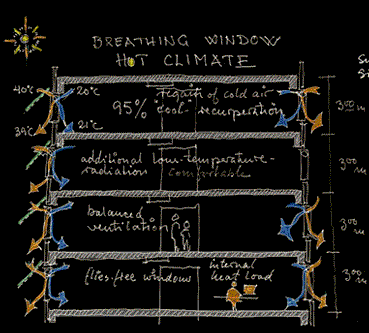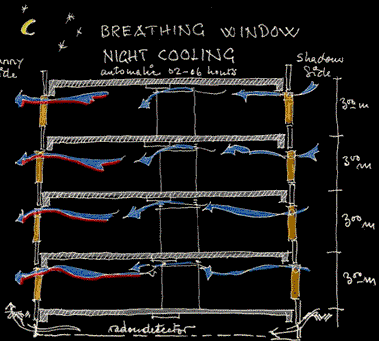|
|
|
|
|
|
|
|||||||||
|
|
|
|||||||||||||
|
|
|
|
||||||||||||
|
|
|
|||||||||||||
|
|
|
|
|
|
|
|
|
|
||||||
|
|
|
|||||||||||||
|
|
|
|
||||||||||||
|
|
|
|
|
|
|
|
|
|
|
|
|
|
|
|
|
|
|
|
|
|||||||||||
|
|
|
|
 |
 |
|
|||||||||
|
|
|
|||||||||||||
 |
 |
|
||||||||||||
|
|
|
 |
|
|||||||||||
|
|
 |
|
||||||||||||
|
|
|
|
|
|||||||||||
|
|
|
|||||||||||||
|
|
|
|||||||||||||
THE IDEA AND THE METHODOLOGY OF THE DEVELOPMENT OF NEW DECENTRALISED VENTILATION
We start again from the very beginning. The shape, dimension and capacity of a breathing window still are unknown.
Vertical position is better for the temperature stratification and to solve the condensation and icing problem in cold climates. The expected personal attitude asks for almost daily contact with users to achieve good indoor air quality and cleaning capacity. �Build in� breathing windows are in upright position easy to mount.
With the second generation of the experimental breathing windows, the dimensions are changing slightly.
|
|
Descriptions of the design What measures, outward appearances and ventilation capacities the breathing window will have is still being investigated. The dimensions of the first generation prototypes are (DxWxH) 180/200/700 mm. [3]. The fine-wire heat exchanger fits easily into a standard dishwasher and therefore can be cleaned easily. The breathing window functions very well together with natural ventilation, hybrid or completely balanced mechanical ventilation. The CO2 sensor starts automatically, 500 ppm when addition to natural ventilation is needed, but also gives signal when at 1200 ppm (MAC value) doors and windows have to be opened for a healthy indoor climate. There are three different possibilities of integration in the fa?ade of several types of buildings: as part of transparent glass, as vertical window frame, or the most probable solution, as part of a closed panel or wall in new or even existing buildings. The larger the vent hole, the lower the air velocity. The noise production decreases, however the wind effects increase in high-rise buildings. When turning on the hood, or putting on the light in the toilet or bathroom, the balanced ventilation gets slightly disturbed and causes the necessary overpressure and resulting extra air supply.
|
|
|
||||||||||
|
|
|
|||||||||||||
|
|
|
|
|
|
|
|
|
|
|
|
|
|
|
|